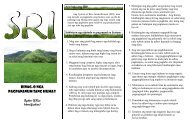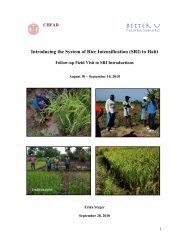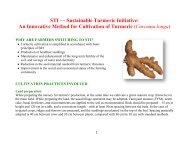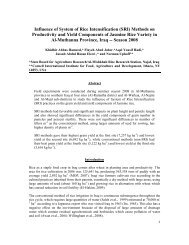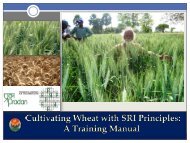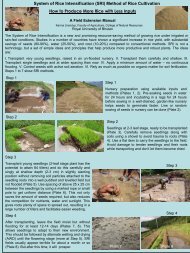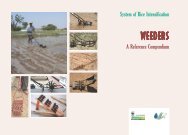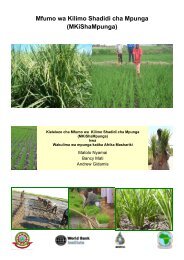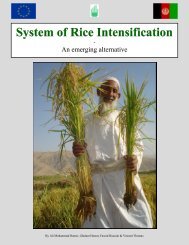EFFECT OF THE SYSTEM OF RICE INTENSIFICATION (SRI) ON ...
EFFECT OF THE SYSTEM OF RICE INTENSIFICATION (SRI) ON ...
EFFECT OF THE SYSTEM OF RICE INTENSIFICATION (SRI) ON ...
You also want an ePaper? Increase the reach of your titles
YUMPU automatically turns print PDFs into web optimized ePapers that Google loves.
Abstract<br />
The System of Rice Intensification (<strong>SRI</strong>) has been adopted by many resource poor farmers<br />
throughout the world. In Cambodia approximately 80.000 farmers practice some sort of <strong>SRI</strong> and<br />
farmers are able to increase their rice yields with lower input costs. <strong>SRI</strong> is based on transplanting<br />
one seedling per hill as opposed to several for traditional rice and managing a drying and flooding<br />
regime of the soil leading to alternately anaerobic and aerobic conditions.<br />
This study targeted farmers in the ILFARM project (Improved Livelihood of Small Farmers)<br />
initiated by the Cambodian NGO CEDAC (Centre d’Étude et de Développement Agricole<br />
Cambodgien) and the Danish organization NORDECO (Nordic Agency for Development and<br />
Ecology) in Cambodia’s Prey Veng province. The objectives were to evaluate the effect of <strong>SRI</strong> on<br />
the farmers’ livelihood situation, potentials of increasing the soil Carbon pool and mitigation of<br />
greenhouse gases (CH4, N2O and CO2). The applied methods were interviewing households in the<br />
target group and soil sampling in the <strong>SRI</strong> fields for total Carbon and Nitrogen respectively.<br />
The target farmers were able to increase their rice yields significantly using <strong>SRI</strong> as compared to<br />
their traditional rice fields. Traditional rice fields yielded 2.19 t ha -1 and <strong>SRI</strong> fields yielded<br />
3.53 t ha -1 respectively. The main reason seems to be the use of only one seedling per hill thus<br />
reducing the competition for nutrients. The use of water management was not practiced due to no or<br />
little irrigation facilities. Main constraints for further development of <strong>SRI</strong> would be the lack of high<br />
amounts of biomass. In order to cope with this, the ILFARM project will however supply the<br />
farmers with 500.000 trees in order to increase the amount of available on site biomass. It was<br />
estimated that such measures could increase the soil C pool with roughly 116 kg C ha -1 year -1 . The<br />
<strong>SRI</strong> conducted by the target farmers did not have large influences on mitigation as farmers were not<br />
able to manage a fluctuating water table due to no irrigation facilities. However if all concepts of<br />
<strong>SRI</strong> is followed this could decrease emissions of especially CH4.<br />
<strong>SRI</strong> appears to be a suitable and sustainable way of growing rice for resource poor farmers and in<br />
addition it carries the potentials of being able to increase soil fertility through an increased C pool<br />
and mitigation possibilities of greenhouse gases.<br />
3



